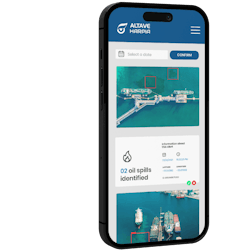ROG.e 2024: AI is set to protect sea life and offshore operations resources from oil leaks
By Bruno Avena, ALTAVE
Oil spills at sea represent severe threats to marine and coastal ecosystems worldwide. According to the International Tanker Owners Pollution Federation (ITOPF), an average of 6.3 significant incidents (more than 7 tons) occurred annually over the past decade. In 2023, approximately 2,000 tons of oil spilled into the oceans. These incidents devastate local biodiversity and severely impact coastal economies, affecting fishing, tourism and maritime recreation industries.
The importance of early detection and rapid response in mitigating the impacts of environmental disasters cannot be overstated. Traditionally, monitoring oil spills relied on visual inspections by human teams or fixed sensors, methods often insufficient due to the vastness of areas and unpredictability of incidents.
Artificial intelligence (AI) and video analytics have emerged as revolutionary technologies in the fight against oil spills, offering a more effective approach to monitoring and early detection of leaks.
High-resolution cameras and sophisticated sensors, powered by video analytics systems and AI, continuously monitor ocean areas. A key innovation is the use of aerostats (tethered balloons) as platforms for these monitoring systems. Strategically positioned aerostats offer a cost-effective solution for wide-area surveillance, providing a stable, elevated vantage point for cameras and sensors. This approach reduces maintenance costs compared to traditional fixed installations or manned aircraft while offering extended operational time and broader coverage.
Machine learning algorithms are trained to recognize specific patterns indicating the presence of oil. These systems can detect subtle changes in light reflection, water texture and marine life behavior that may indicate contaminants.
One main advantage of this technology is its ability to operate 24/7 without fatigue, making constant surveillance impossible with human teams alone. These systems can cover larger areas than traditional methods, increasing the likelihood of early leak detection.
When a potential spill is detected, the system immediately alerts response teams, providing accurate data on the oil slick’s location, extent and movement. This real-time information is crucial for effective response, allowing quick mobilization of containment and cleanup teams.
AI also has the potential to contribute to the prediction of oil movement and dispersion. Using data on ocean currents, winds and other factors, algorithms can predict the likely trajectory of the spill, allowing authorities to take preventive measures to protect sensitive areas and optimize containment efforts.
While these technologies offer great potential, they are not a standalone solution. Effective implementation requires an integrated approach, combining AI and video analytics with other remote sensing technologies and human expertise.
Ongoing development and improvement of these systems remain crucial, with efforts focused on training algorithms with various scenarios, improving accuracy in detecting different types of oil and conditions, and integrating with existing emergency response systems.
Collaboration between governments, industries and environmental organizations is crucial to implement and enhance these technologies. By increasing investment in research and development, this improve the ability to respond swiftly and effectively to oil spills as well as drives innovations that will safeguard marine environments and advance ocean monitoring on a broader scale.
ALTAVE is exhibiting at booth M19 at ROG.e 2024 this week in Rio de Janeiro, Brazil.
About the Author

Bruno Avena
Bruno Avena, CEO of ALTAVE, is an aeronautical engineer and entrepreneur with exceptional academic credentials, including a doctorate from ITA and experience at NASA. Currently, he leads ALTAVE's business strategy, setting objectives and policies to achieve the company's vision. With his solid technical background and strategic vision, Avena significantly contributes to the advancement of aerospace engineering and the success of ventures in intelligent monitoring.


